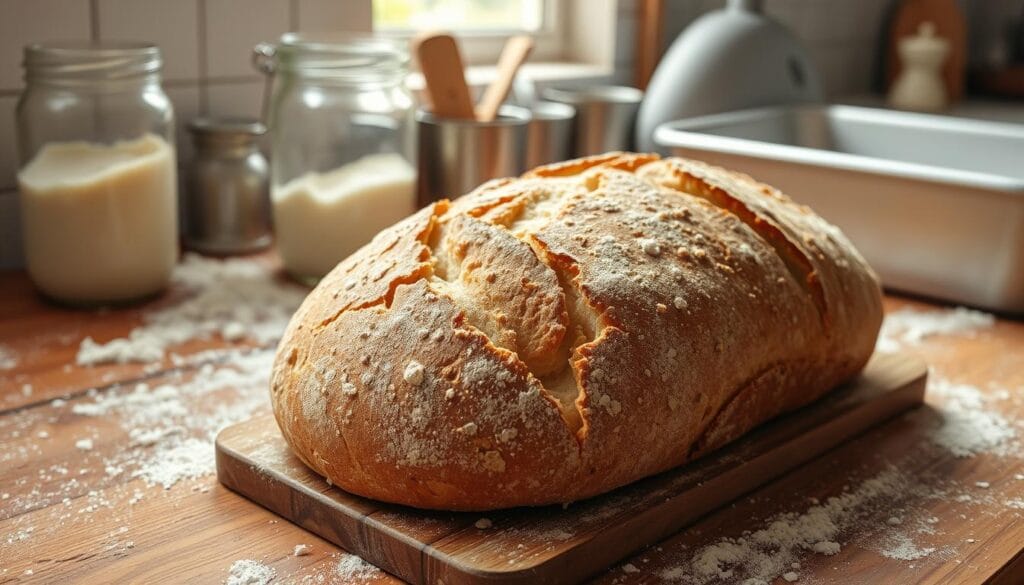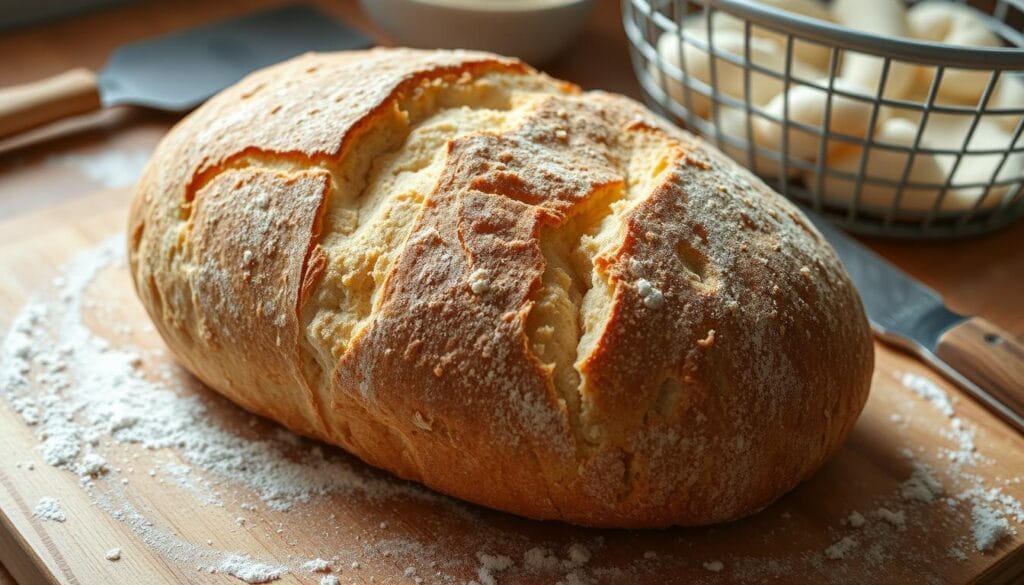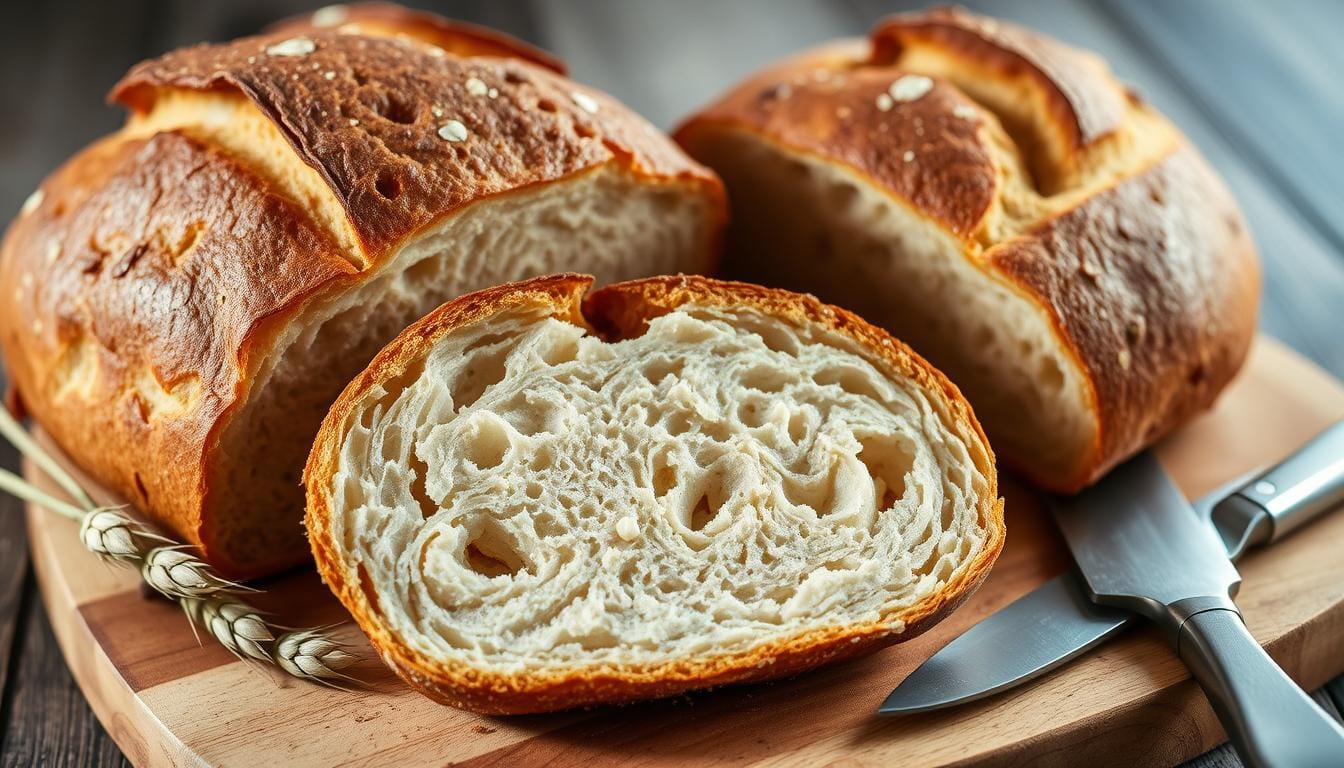Easy Sourdough Sandwich Bread Recipe | Perfect for Beginners
Table of Contents
There’s nothing quite like the aroma of freshly baked bread in your kitchen. It’s a joy that comes from mastering sourdough. But, starting can seem scary. Don’t worry, this easy sourdough sandwich bread recipe is perfect for beginners.
Imagine biting into a soft, fluffy slice of homemade bread. It’s perfect with your favorite sandwich or a warm bowl of soup. This recipe makes a tender loaf with a slight tang. It’s easy to follow, making it perfect for beginners.
Why Make Your Own Sourdough Sandwich Bread
Making your own sourdough sandwich bread at home has many benefits. You get to choose what goes into it. Plus, it’s healthier and tastes better, with fewer additives.
Benefits of Homemade Bread
Creating your own bread is rewarding and saves money. The joy of kneading and watching it rise is unique. Plus, homemade bread is often cheaper than store-bought.
Understanding Sourdough Fermentation
The secret to great sourdough bread is knowing how it ferments. This natural process uses a sourdough starter. It makes the bread taste tangy and complex.
Health Benefits of Sourdough
- Improved digestibility: The fermentation breaks down gluten, making it easier to digest.
- Increased nutrient absorption: Sourdough has more vitamins and minerals that the body can use better.
- Lower glycemic index: The fermentation slows down sugar absorption, keeping blood sugar levels steady.
Learning about homemade fermented dough and sourdough bread baking lets you make tasty and healthy homemade bread. It will make your sandwiches and snacks even better.
Essential Ingredients for Perfect Sourdough Sandwich Bread
To bake great sourdough sandwich bread, you need top-notch ingredients. You’ll need unbleached bread flour, active sourdough starter, and water. A bit of honey or maple syrup adds sweetness. Olive oil and kosher salt boost the flavor.
The recipe calls for:
- 500g unbleached bread flour
- 275g water
- 50g active sourdough starter
- 60g olive oil
- 10g kosher salt
Some recipes might use buttermilk or eggs for extra richness. But the main ingredients listed are key for perfect sourdough sandwich bread. High-quality flour, like King Arthur Bread Flour, and an active sourdough starter are vital for the right texture and taste.
| Ingredient | Amount |
|---|---|
| Unbleached Bread Flour | 500g |
| Water | 275g |
| Active Sourdough Starter | 50g |
| Olive Oil | 60g |
| Kosher Salt | 10g |
Using the right sourdough starter, bread flour, and exact measurements is key for perfect whole wheat sourdough sandwich bread. With these ingredients, you’re set to make a tasty homemade loaf.
Required Tools and Equipment
Learning to make bread baking, like no-knead bread, needs some key tools. You don’t need a fancy kitchen to make tasty sourdough sandwich bread. But, the right tools can help make the process easier and faster.
Basic Kitchen Tools
- A 9″ x 5″ loaf pan for baking the perfect-sized sandwich bread
- A stand mixer (optional, but helpful for kneading the dough)
- A dough whisk or spatula for mixing the ingredients
- A kitchen scale for accurately measuring the ingredients
Optional but Helpful Equipment
- A Danish dough whisk for thoroughly incorporating the ingredients
- A metal bench scraper for handling the dough and shaping the loaves
- A baking thermometer to ensure the bread is cooked to the ideal internal temperature
Storage Containers
After baking your sourdough sandwich bread, you’ll want to store it right. Use a bread box or a beeswax bread cloth to keep it fresh. A Pullman loaf pan can also help for a uniform shape and tighter crumb, great for sandwiches.
| Tool/Equipment | Purpose |
|---|---|
| 9″ x 5″ Loaf Pan | Baking the perfect-sized sandwich bread |
| Stand Mixer (optional) | Kneading the dough |
| Dough Whisk or Spatula | Mixing the bread ingredients |
| Kitchen Scale | Accurately measuring ingredients |
| Danish Dough Whisk | Thoroughly incorporating ingredients |
| Metal Bench Scraper | Handling and shaping the dough |
| Baking Thermometer | Ensuring the bread is cooked to the ideal internal temperature |
| Bread Box or Beeswax Cloth | Storing the baked loaf to maintain freshness |
| Pullman Loaf Pan | Baking the bread for a more uniform shape and tighter crumb |
With the right tools and equipment, you’re ready to bake delicious sourdough sandwich bread. Your family and friends will love it. Try different flours, fermentation methods, and storage ways to find what works best for you.
Preparing Your Active Sourdough Starter
To make the perfect sourdough sandwich bread, you need an active and bubbly sourdough starter. Feed your starter 12 hours before mixing the dough. This is key for a good rise and flavor. Use a 1:4:4 ratio (starter:flour:water) for a slow rise or 1:1:1 for quicker activation.
The sourdough starter should be at its peak when you’re ready to use it. For a 50g active starter, mix 10g starter, 25g flour, and 25g water. Some recipes let you use an unfed, cold starter straight from the fridge.
| Ingredient | Amount |
|---|---|
| Active sourdough starter | 150g (3/4 cup) |
| Warm milk | 300g (1 1/4 cups) |
| Honey | 40g (2 Tablespoons) |
| Unsalted butter, melted | 57g (4 Tablespoons) |
| Whole wheat flour | 125g (1 cup) |
| Bread flour | 375g (2 2/3 cups) |
| Salt | 9g (1 1/2 teaspoons) |
By following these guidelines, you’ll have a bubbly and active sourdough starter. It will transform your dough into a delicious, fermented sandwich loaf. Let’s move on to the next step of the recipe!
Sourdough Sandwich Bread Recipe: Step-by-Step Instructions
Get ready to bake a delicious sourdough bread perfect for sandwiches. This recipe will take you through the key steps, from mixing the dough to shaping the loaf. You’ll love the tangy flavor and soft texture of homemade sourdough bread.
Mixing the Dough
Start by mixing your active sourdough starter, bread flour, water, and salt in a stand mixer or large bowl. Mix until a shaggy dough forms. If kneading by hand, do it for 8-10 minutes until smooth and elastic. Let the dough rest for 1 hour before moving on.
Bulk Fermentation Process
The bulk fermentation stage is key for flavor and structure. Put the dough in a lightly greased bowl, cover, and ferment at 68-72°F for 10-12 hours. The dough will double in size, so choose a container that can expand.
Shaping Techniques
After bulk fermentation, gently punch down the dough to release air pockets. Shape it into a tight loaf and put it seam-side down in a greased 9×5-inch loaf pan. Cover and let it rise for 2-3 hours more.
Some recipes use a stretch-and-fold technique instead of kneading. This method involves stretching and folding the dough during bulk fermentation to build gluten structure.
With these steps, you’re on your way to baking perfect sourdough sandwich bread. Adjust fermentation times based on your kitchen’s temperature and sourdough starter activity. Enjoy the journey and the tasty outcome!
Baking Tips for the Perfect Loaf
Making the perfect loaf of artisan bread is more than just a recipe. It’s the baking techniques that truly make the difference. Whether you’re new to bread baking or a pro, these tips will help you make a beautiful, golden-crusted sourdough sandwich bread. It’s sure to impress anyone.
- Preheat your oven to 450°F (232°C), then lower it to 375°F (191°C) when you put the loaf in.
- Make steam in the oven by spraying water on the walls or adding ice cubes to a preheated tray. This helps get a crisp, shiny crust.
- Bake the loaf until it reaches 195°F (91°C) inside. This makes sure the center is fully cooked.
- Allow the bread to cool in the pan for 10 to 15 minutes before transferring it to a wire rack. This keeps the bottom from getting soggy.
- Let the loaf cool completely, about 1-2 hours, before slicing. Cutting into a warm loaf can make it gummy and uneven.
| Pan Size | Total Dough Weight |
|---|---|
| 9 x 4 x 4 Pullman Pan | 800-900g |
| 8.5 x 4.5 x 2.5 Small Loaf Pan | 600-700g |
| 9 x 5 x 2.75 Medium Loaf Pan | 700-800g |
| 13 x 4 x 4 Pullman Pan | 1,100-1,200g |
By following these baking tips and using the right pan size, you’ll make the perfect loaf of artisan bread. It will delight your senses and impress your guests.

“The smell of freshly baked bread is one of the most comforting and inviting aromas in the world.”
Storage and Shelf Life
After baking your homemade sourdough bread, it’s key to store it right. This keeps it fresh and tasty. Knowing how to store your sourdough sandwich bread is crucial to avoid it getting stale too fast.
Room Temperature Storage
Your sourdough bread will stay fresh for up to 3 days at room temperature. Wrap it in a bread bag, beeswax wrap, or a clean towel. Don’t use airtight containers, as they can cause mold.
Freezing Instructions
To store it longer, freeze your sourdough bread. Slice it and put the slices in a freezer-safe container or bag. You can toast slices straight from the freezer without defrosting. This way, your sourdough bread can last up to 6 months.
Reheating Methods
To warm up frozen sourdough bread slices, use a toaster or oven. This method brings back the bread’s crisp crust and soft inside. You can also thaw slices at room temperature before toasting or warming in the oven.
By using these storage and reheating tips, you can enjoy your homemade bread for days or weeks. With the right methods, you can enjoy the taste and texture of your sourdough sandwich bread for a long time.
Troubleshooting Common Issues
Baking sourdough bread can be rewarding but comes with challenges. If you face any issues, don’t worry. We’ve got solutions to help you make the perfect sourdough bread.
Adjusting Fermentation Times
The time your sourdough bread ferments can change with your kitchen’s temperature. In cooler places, use a more active starter or let it ferment longer. In warmer areas, watch the dough closely to avoid over-proofing.
Managing Sticky Dough
If your dough is too sticky, add flour a tablespoon at a time until it’s right. Mix the flour gently to avoid overworking the dough.
Dealing with Over-Proofed Dough
Don’t worry if your dough over-proofs. You can still use it. Try shaping it into a rustic focaccia instead of a traditional loaf. This way, you can still enjoy your bread baking efforts.
Consistency is key in sourdough bread baking. Pay attention to your measurements, ingredients, and fermentation process. This will help you get consistent results.
| Common Issue | Possible Cause | Solution |
|---|---|---|
| Sluggish Sourdough Starter | Inadequate feeding, temperature fluctuations | Ensure a warm environment, try different flours, use varied water sources, and feed the starter twice a day until it becomes more active |
| Hooch (Liquid on Top) | Normal byproduct of fermentation | Stir the hooch back into the starter before using |
| Clear Liquid at Bottom | Feeding imbalance | Adjust the feeding ratio of flour, water, and starter |
| Pink or Orange Discoloration | Starter is starving | Start the sourdough starter process again with fresh flour and water |
| Mold Growth | Contamination from flour or jar | Use a clean jar and consider switching to a different flour brand |
Baking sourdough bread is an art that takes practice. Finding what works for you may require some experimentation. But with patience and persistence, you’ll enjoy delicious homemade sourdough bread with family and friends.

Conclusion
This easy sourdough sandwich bread recipe is great for beginners. It makes a soft, flavorful loaf perfect for everyday use. With practice, you’ll get better at working with the dough, making delicious bread every time.
Homemade sourdough is not only tasty but also healthy and cost-effective. It’s rewarding to make your own artisan bread. This recipe is easy to follow, thanks to its forgiving fermentation process and clear instructions.
It’s perfect for anyone wanting to improve their bread-making skills or just enjoy a healthier, tastier option. This sourdough sandwich bread will quickly become a favorite in your kitchen.
By using natural fermentation and quality ingredients, you can make artisanal bread easily. So, get your tools ready, activate your sourdough starter, and start baking. You’ll make sandwiches and toast even better.
FAQ
What is the purpose of this sourdough sandwich bread recipe?
This recipe produces a soft and fluffy sourdough sandwich bread ideal for both sandwiches and toast. It is designed to be simple enough for beginners using ingredients like all-purpose flour, olive oil, honey, salt, and sourdough starter.
What are the benefits of making your own sourdough bread?
Baking your own sourdough allows you to select the ingredients, resulting in a healthier loaf with fewer additives. The sourdough process also enhances both flavor and texture and aids digestion. Additionally, it can be economical and a soothing activity. Understanding fermentation principles is key for successful sourdough baking.
What are the essential ingredients for this sourdough sandwich bread recipe?
The essential components include unbleached all-purpose flour, water, active sourdough starter, honey or maple syrup, olive oil, and kosher salt. The recipe specifically calls for 500g flour, 275g water, 50g starter, 60g olive oil, and 10g salt. High-quality ingredients are vital for achieving the best flavor.
What tools and equipment are needed for this recipe?
Necessary tools include a 9″ x 5″ loaf pan, a stand mixer (optional), a dough whisk or spatula, and a kitchen scale. A Danish dough whisk, a metal bench scraper, and a baking thermometer are helpful additions. For storage, consider using a bread box or beeswax wrap, while a Pullman loaf pan can create a uniform shape.
How do I prepare my active sourdough starter?
Feed your sourdough starter 12 hours before you plan to mix the dough. For a slow rise, use a 1:4:4 ratio (starter:flour:water), or maintain a 1:1:1 ratio for quicker activation. Ensure that the starter is bubbly and active when you use it. To prepare 50g of active starter, combine 10g starter, 25g flour, and 25g water. Some recipes allow the use of unfed, cold starters straight from the fridge.
What are the steps for making the sourdough sandwich bread?
Combine the ingredients in a stand mixer or pay attention while mixing by hand. Allow the dough to rest for an hour, and then knead for 8-10 minutes. The bulk fermentation phase lasts for 10-12 hours at 68-72°F. Shape the dough into a loaf and place it in a greased pan, allowing for a second rise of 2-3 hours. Bake at 375°F for 45-50 minutes and create steam in the oven. It’s best to wait until the loaf cools completely before slicing.
How do I store and reheat the sourdough sandwich bread?
Store the bread in a bread bag, beeswax wrap, or clean towel at room temperature for about three days. For longer storage, slice the bread and freeze it in a freezer-safe container. Toast the frozen slices directly from the freezer. The bread remains fresh for up to three days at room temperature, but it’s recommended to wait until the next day to slice for optimal sandwich thickness.
What are some common issues I might encounter when baking this sourdough bread?
Fermentation times may need adjustment depending on your kitchen temperature. Use a more active starter or let the dough ferment longer in cooler temperatures, and monitor closely in warmer conditions to prevent over-proofing. If the dough is too sticky, add more flour. For over-proofed dough, consider crafting focaccia instead. Consistency in measurements and ingredients is essential for reliable results.
Tried This Recipe? Leave Your Review!
There are no reviews yet. Be the first one to write one.

